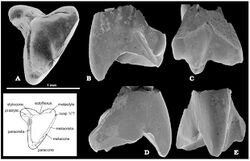Biology:Crusafontia
| Crusafontia | |
|---|---|

| |
| Holotype of C. amoae, now C. cuencana | |
| Scientific classification | |
| Domain: | Eukaryota |
| Kingdom: | Animalia |
| Phylum: | Chordata |
| Class: | Mammalia |
| Order: | †Dryolestida |
| Family: | †Dryolestidae |
| Genus: | †Crusafontia Henkel & Krebs, 1969 |
| Type species | |
| Crusafontia cuencana Henkel & Krebs, 1969[1]
| |
| Synonyms[2] | |
| |
Crusafontia is an extinct genus of mammal from the Cretaceous Camarillas, El Castellar and La Huérguina Formations of Spain.[1][2][3][4] The name of the animal was given in honour of the Spanish paleontologist Miquel Crusafont Pairó.
Crusafontia was a 10 cm (3.9 in) long creature that may have looked and lived like a squirrel, but this is uncertain, as only two teeth (an upper molar right P5) and a mandible have ever been found.[1][3][4] In one study on Mesozoic mammal mandibles, it plots with carnivorous rather than insectivorous or herbivorous species.[5]
In 2011 a second species of Crusafontia was named, C. amoae, based on two upper molar teeth from Galve.[2] However, this was synonymised with the original species in 2021.[6]
References
- ↑ 1.0 1.1 1.2 Henkel, S. and Krebs, B., 1969. Zwei Säugetier-unterkiefer aus der unteren Kreide von uña (prov. Cuenca, Spanien). Neues Jahrbuch für Geologie und Paläontologie, 1969, pp.449-463.
- ↑ 2.0 2.1 2.2 Cuenca-Bescós, G., Badiola, A., Canudo, J.I., Gasca, J.M. and Moreno-Azanza, M., 2011. New Dryolestidan Mammal from the Hauterivian—Barremian Transition of the Iberian Peninsula. Acta Palaeontologica Polonica, 56(2), pp.257-267.
- ↑ 3.0 3.1 Crusafontia cuencana in the Paleobiology Database
- ↑ 4.0 4.1 Crusafontia amoae in the Paleobiology Database
- ↑ Morales-García, N. M.; Gill, P. G.; Janis, C. M.; Rayfield, E. J. (2021). "Jaw shape and mechanical advantage are indicative of diet in Mesozoic mammals". Communications Biology 4 (1): 242. doi:10.1038/s42003-021-01757-3. PMID 33623117.
- ↑ Martin, T., Averianov, A.O., Schultz, J.A., Schwermann, A.H. and Wings, O., 2021. A derived dryolestid mammal indicates possible insular endemism in the Late Jurassic of Germany. The Science of Nature, 108(3), pp.1-12
Wikidata ☰ Q3267608 entry
 |

